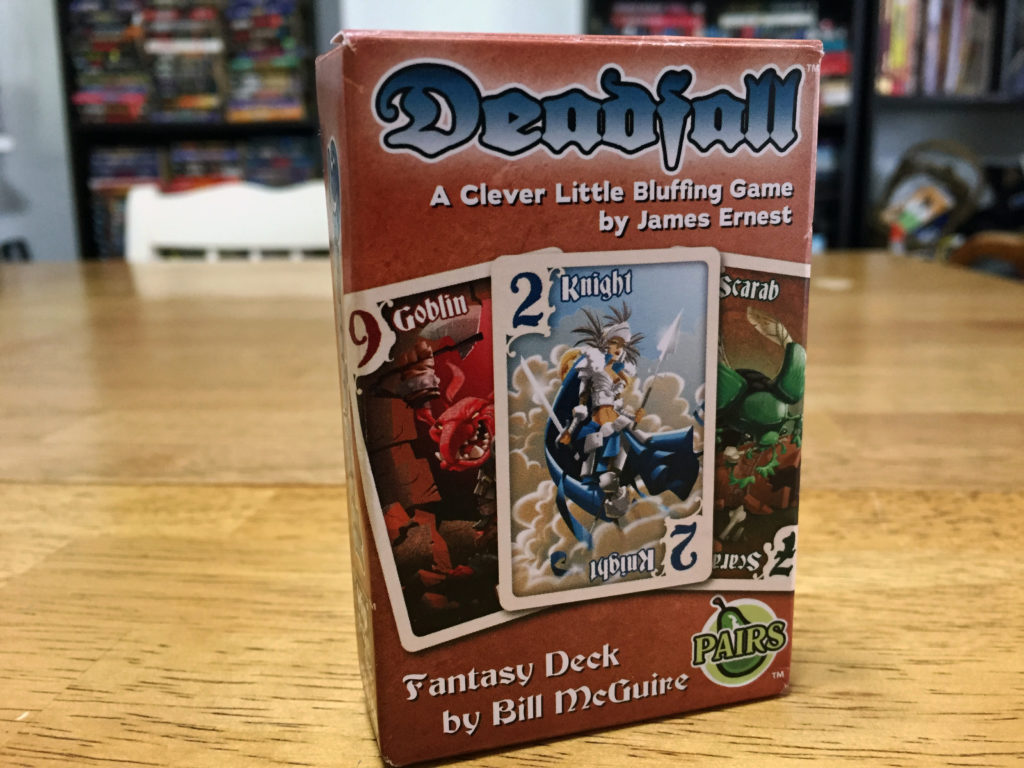“Deadfall” sounds like the title of the next James Bond movie, but it’s actually a card game that’s both easy and relatively quick to play. In Deadfall, players will be utilizing a “Pairs” deck…that is, a deck of cards valued 1-10 consisting of one 1, two 2’s, three 3’s, and so on. Players receive 50 coins or chips (not included) to start their pool along with a hand of six cards (five in a seven player game, seven in a two player game). Special thanks to Cassidy Werner from Cheapass Games for providing me with a press copy for review purposes.

Deadfall: 2-7 Players, Ages 8+, Average Play Time = 30-45 Minutes
Review
Editor’s Note: Rather than type out the components, game setup, and how the game plays here, I took the liberty of recording a video outlining most/all of the game’s features. It’s easier for me to do it this way as I have been very busy as of late both personally and professionally. You can find it at the bottom of this section.
Firstly, let’s the gripes out of the way. The manual is a bit vague in some places, like what to do when no one calls anyone out during a round and everyone runs out of cards. I didn’t see a place in the manual to where players draw a card after playing one, but I suspect this would be an interesting alternative. It would extend the game’s length tenfold since you wouldn’t know for sure which cards were “dead” until you started seeing a bunch on the table and the deck running dry. The box is also misleading as it lists the game as having a five-minute play time. I’d have to go with a thirty minute play time with each round taking two to three minutes. Of course, you can modify the end game conditions to fit a quick session. For example, whoever has the most coins/chips after three/five/whatever rounds wins. In effect, YOU can set the play time average.
Issues with the rulebook and its clarity aside, I think “Deadfall” is a pretty neat filler. There’s some bluffing involved, not to mention risk with every card you play. Essentially, you’re aiming to get people to call you when you have a duplicate of a card you’ve played in your hand and/or call on someone when you’re almost certain that no one else has that value in their hands. The opening door card (which everyone plays at the same time) can be a game-ender too, especially if someone plays a “2” and someone else plays a “1”. The player with the “1” goes first and there’s a good chance no one would have the other “2” (though it’s possible). The lower the card you play in general, the less likely that there will be duplicates somewhere else in everyone else’s hand.
For kicks, I recommend playing with a ten card hand with two players, as a seven card hand is over pretty quickly. It also gives players a chance to bluff more as they’ll have more cards at their disposal and less likely to be called with almost every low-card play. Alternatively, folks could be dealt so many cards (face-down) that they can’t play but have knowledge as to what may still be left in other player’s hands. Or, create a public face-up pool that everyone can see. What’s cool about this “Pairs Deck” is that it’s compatible with other games that utilize the same deck. Some cool game variants can be found on the official website (link below) should you want to try something other than the rules associated with “Deadfall”. You can find this particular deck on Amazon for $10 (use the right sidebar search feature to find it) making it a decently priced filler for your collection that offers a ton of value.
Final Verdict: 9/10
—
Variants: http://www.cheapass.com/freegames/workshop55
—

If a player plays the last card, the next player can call any player and win the call, since there are no cards left. Given that, if I am the last player with a card and I see someone played a card that’s the same rank as mine, I will call him and will the call.